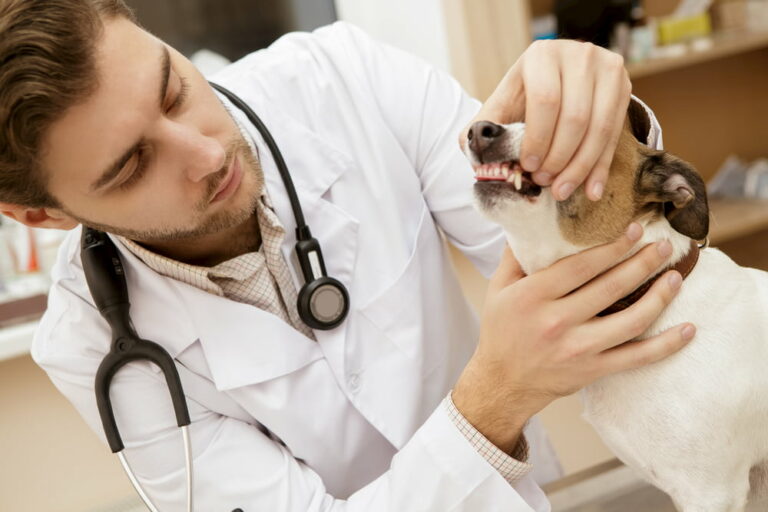Pale Gums in Dogs: 10 Reasons It Might Be Happening

Overview
- Pale gums could signal a medical emergency and dogs should be seen by a vet as soon as possible.
- Normal dog gums are pink in color and moist to the touch.
- Causes of pale gums range from internal bleeding and anemia to cancer and kidney disease.
- Pet parents should regularly check their dog's gums a few times each month.
When it comes to our dogs’ oral health, we typically envision a pretty set of pearly white teeth. But teeth are just part of the dental health equation. The gums provide a crucial window into a dog’s overall health. And, when you notice pale gums in dogs, it’s a clue to a serious, underlying health condition that always requires further investigation.
Let’s explore why dogs have pale gums and what you can do about it.
Dog Gum Basics: What Color Should a Dog’s Gums Be?
The gums are one of several structures in the mouth that support the teeth. Healthy, normal gums in dogs have a pink or salmon color. The gums are pink because of the many tiny blood vessels just under the gums’ surface.
Healthy dog gums are also shiny and moist, indicating that your pup is well-hydrated.
There are variations in the normal color of a dog’s gums. For example, some dogs have mottled or pigmented gums, meaning that the gums have spots of dark pigment. This is nothing to worry about.
Checking Your Dog’s Gums

As a responsible pet parent, you already know about closely monitoring your pet’s health and behavior so that you can detect when something’s not right.
This monitoring should include checking your dog’s gums. Fortunately, this is easy to do and not at all uncomfortable for your dog.
How do you check your dog’s gums?
Gently lift the upper lip and pull down the lower lip to observe your dog’s gum color. The color of gums in dogs should be pink or salmon.
Next, gently touch your dog’s gums to determine if they feel moist. Gums that feel a little sticky or tacky could indicate dehydration.
You can also perform the capillary refill test, which is a quick way to evaluate hydration status and blood flow to the gums. Gently press your index finger to your dog’s gums and lift your finger back up. The area you pressed will be white from your finger’s pressure, then return to the normal pink color in 1-2 seconds. This indicates adequate hydration and a quick refill of the blood vessels.
If more than 1-2 seconds pass before your dog’s gums turn pink again, your dog may be dehydrated or have an underlying health problem that is affecting circulation.
How often should you check your dog’s gums?
Check your dog’s gums at least once or twice a month. However, it’s best to check the gums each time that you brush your dog’s teeth, which should be daily. Take note of any change in the gum’s feel and appearance.
If your dog has mottled or pigmented gums, you may find it challenging to see the capillary refill test results and determine if the gums have changed color.
Dog pale gums range from pale pink to white. Because pale gums in dogs are usually associated with a problem with hydration or circulation, the gums will probably feel sticky and lose their shiny appearance from a lack of moisture.
Causes of Pale Gums in Dogs

Many health issues can affect a dog’s circulation and lead to pale dog gums. Some of the more common causes of canine pale gums include:
Anemia
Anemia is a decreased number of red blood cells (RBCs). It is not a disease unto itself but rather a consequence of some other disease process. Dogs with anemia are often weak, tired, and have difficulty breathing. They also experience weight loss and have a faster heart rate to pump out more blood.
Kidney Disease
The kidneys produce a substance called erythropoietin (EPO), which stimulates RBC production. During kidney disease, the kidneys stop working well, meaning that EPO production goes down. With less EPO, fewer RBCs are being produced, ultimately leading to pale gums.
Signs of kidney disease include excessive drinking and urination, reduced appetite, vomiting, diarrhea, and weight loss. Chronic kidney disease can cause anemia.
Shock
Shock occurs after a traumatic event, such as getting hit by a car, that causes significant external or internal bleeding. A dog’s circulation plummets, blood vessels constrict, and gums become pale.
Dogs in shock have rapid breathing, a rapid heartbeat, and reduced body temperature.
Shock is an emergency that requires immediate veterinary treatment.
Internal Bleeding
Bleeding internally can result from traumatic injury or organ disease, such as stomach ulcers. It reduces circulation, leading to pale gums in dogs. Signs of internal bleeding may include sudden collapse, lethargy, difficulty breathing, and pot-bellied appearance. Internal bleeding is a medical emergency and you should take your pet to the veterinary hospital immediately.
Parasites
Parasites can wreak havoc by feeding on a dog’s blood and depriving dogs of vital nutrients. Fleas land on a dog’s fur and feed on the blood. A heavy flea infestation can cause significant blood loss, leading to pale gums. Symptoms of a flea infestation include intense itching and hair loss from the constant scratching.
Intestinal parasites like roundworms cause digestive problems, such as vomiting and diarrhea. They can also cause weight loss and reduced energy, and loss of appetite.
Bloat
Bloat in dogs can quickly become a life-threatening condition. When the stomach fills with gas, it can become so distended that it twists upon itself. During this process, blood vessels can either twist or get compressed, leading to poor circulation to parts of the body and pale gums.
Dogs with bloat have distended abdomens, may heave or retch, may collapse and be severely lethargic, or may be restless and uncomfortable.
Blood Clotting Disorders
The blood clotting process is complex. A blood clotting disorder, such as thrombocytopenia (a lack of platelets), disrupts this intricate process and causes abnormal bleeding. Rat bait ingestion can also disrupt this process and cause abnormal bleeding. Pale gums could result from abnormal bleeding.
Signs of blood clotting disorders include excessive bleeding and skin bruises.
Heart Disease
If your dog’s heart cannot pump blood properly, the gums won’t get the blood supply they need to stay healthy, leading to pale gums. Signs of heart disease include lethargy, reduced appetite, coughing, and a fluid-filled abdomen.
Heavy Metal Toxicity
Dogs aren’t exactly picky eaters, so they may eat something that contains heavy metals, such as pennies or nails. Heavy metals like zinc can reduce RBC production, leading to anemia and pale gums.
Heavy metal toxicity also causes symptoms like vomiting, reduced appetite, and lethargy.
Cancer
Cancer robs the body of so much. Many types of cancer can affect dogs. Some types of cancer affect the bone marrow, which produces RBCs. If there’s cancer in the bone marrow, RBC production goes down, leading to anemia and pale gums.
Cancer has a broad range of symptoms that depend on the type of cancer.
What to Do if Your Dog Has Pale Gums

If your dog has pale gums and is lethargic or otherwise not themselves you should go to the vet immediately. Pale gums in dogs are abnormal and always warrant further investigation by a veterinarian.
If your dog is critically ill from shock or bloat, immediately seek veterinary care from your veterinarian or an emergency veterinary hospital. If your dog is in shock from a traumatic injury that’s caused significant bleeding, you can perform first aid by covering the wound with a clean cloth. However, your primary goal is to get your dog treated as soon as possible.
The other causes of pale gums listed above are not necessarily life-and-death medical emergencies. However, because pale gums point to an underlying health problem, your dog will need prompt veterinary care.
Your veterinarian will ask you many questions as they examine your dog to determine the cause of the pale gums. Come prepared with as much information as possible, including what’s listed below:
- First observation of the pale gums
- What the gums looked and felt like
- Other symptoms or changes in behavior
- History of trauma
- History of eating anything toxic or poisonous, such has heavy metals (pennies) or rat bait
A detailed history will give your veterinarian more clues of the underlying problem. After performing a physical examination, they will perform other diagnostic tests, including routine blood work, X-rays, and blood clotting tests.
The sooner your veterinarian can determine what’s causing the pale gums, the sooner your dog can receive treatment and get back to good health.
How to Prevent Pale Gums in Dogs

Since pale gums are a sign of other underlying medical conditions, preventing pale gums in dogs is a matter of staying on top of preventative wellness.
Always keep up with your pet’s vaccine and testing schedules so you can detect medical conditions as early as possible. When you are brushing your dog’s teeth, pay attention to any change in gum color. If you notice anything abnormal, always reach out to your veterinarian to see if further evaluation makes sense.









